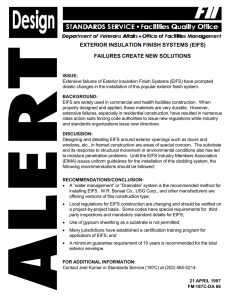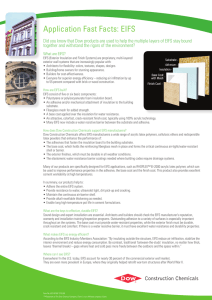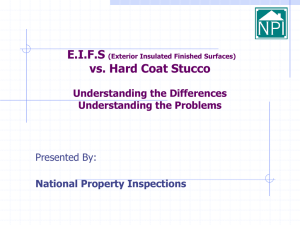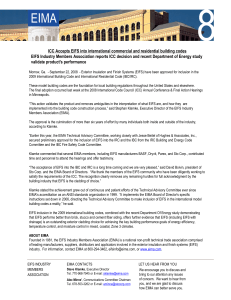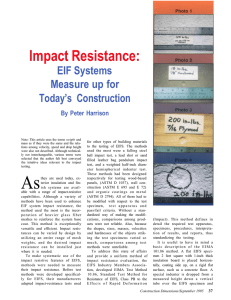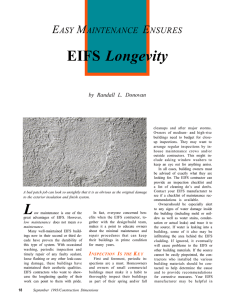Document 12035587
advertisement
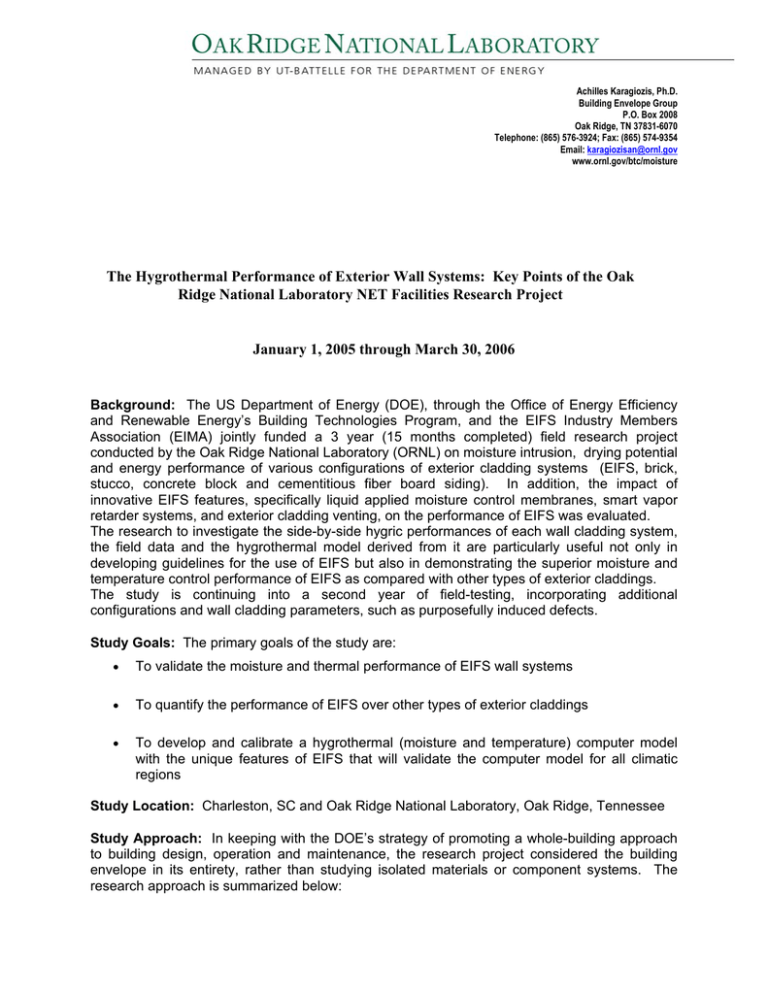
Achilles Karagiozis, Ph.D. Building Envelope Group P.O. Box 2008 Oak Ridge, TN 37831-6070 Telephone: (865) 576-3924; Fax: (865) 574-9354 Email: karagiozisan@ornl.gov www.ornl.gov/btc/moisture The Hygrothermal Performance of Exterior Wall Systems: Key Points of the Oak Ridge National Laboratory NET Facilities Research Project January 1, 2005 through March 30, 2006 Background: The US Department of Energy (DOE), through the Office of Energy Efficiency and Renewable Energy’s Building Technologies Program, and the EIFS Industry Members Association (EIMA) jointly funded a 3 year (15 months completed) field research project conducted by the Oak Ridge National Laboratory (ORNL) on moisture intrusion, drying potential and energy performance of various configurations of exterior cladding systems (EIFS, brick, stucco, concrete block and cementitious fiber board siding). In addition, the impact of innovative EIFS features, specifically liquid applied moisture control membranes, smart vapor retarder systems, and exterior cladding venting, on the performance of EIFS was evaluated. The research to investigate the side-by-side hygric performances of each wall cladding system, the field data and the hygrothermal model derived from it are particularly useful not only in developing guidelines for the use of EIFS but also in demonstrating the superior moisture and temperature control performance of EIFS as compared with other types of exterior claddings. The study is continuing into a second year of field-testing, incorporating additional configurations and wall cladding parameters, such as purposefully induced defects. Study Goals: The primary goals of the study are: • To validate the moisture and thermal performance of EIFS wall systems • To quantify the performance of EIFS over other types of exterior claddings • To develop and calibrate a hygrothermal (moisture and temperature) computer model with the unique features of EIFS that will validate the computer model for all climatic regions Study Location: Charleston, SC and Oak Ridge National Laboratory, Oak Ridge, Tennessee Study Approach: In keeping with the DOE’s strategy of promoting a whole-building approach to building design, operation and maintenance, the research project considered the building envelope in its entirety, rather than studying isolated materials or component systems. The research approach is summarized below: • Characterize the moisture, and thermal performance properties of critical construction materials and sub-systems used in exterior wall systems • Confirm the predictions of computer model by comparing them to actual field results • Conduct field testing on a variety of exterior wall systems to determine their thermal, air leakage and moisture control performance in real world, average environmental conditions, including some severe-environmental conditions, during the course of one year • Employ hygrothermal modeling to simulate field tested exterior wall systems to determine how to improve critical cladding system elements, with the goal of optimizing their performance • Develop design methodology that will permit architects and engineers to optimize energy efficiency while controlling air and moisture transport to prevent material deterioration and potential fungal contamination of the indoor environment Facility Design. To achieve these goals, a special building was designed and constructed near Charleston, South Carolina. The 15 exterior cladding configurations to be evaluated were integrated into one side of the building (southern exposure). In this way, all of the exterior claddings would be exposed to similar weather conditions during the course of the study. Building orientation and placement of the exterior wall test panels were determined after considerable study of historical weather patterns, including the prevailing direction of precipitation. Exterior Cladding Panel Configurations. While other types of exterior claddings were studied, the primary focus of this project was various EIFS configurations, including EIFS with drainage systems. Sensor Placement and Data Collection. Each of the wall panels contained a variety of sensors that recorded a full, constant profile of temperature, heat flux, relative humidity, and moisture content. These sensors collected data 24 hours a day, 7 days a week and transmitted the data to the ORNL Building Thermal Envelope Systems & Materials Energy Division Research facility in Oak Ridge, Tennessee for analysis. Data upon which the conclusions were derived were collected during a period of 15 months, January 1, 2005 through March 30, 2006, and included average monthly weather observations and both interior and exterior sensor readings. Results and Conclusions. The research data lead to the following findings and support the following statements: • The best performing wall system was the EIFS wall consisting of four inches of expanded polystyrene insulation board without any interior stud insulation (no fiberglass). This wall outperformed all other walls in terms of moisture while maintaining superior thermal performance. EIMA Research Project Page 2 of 3 Oak Ridge National Laboratory • The brick clad wall systems tended to accumulate more moisture and retain moisture longer than EIFS cladding. • The cementitious fiberboard siding wall systems tended to accumulate more moisture and retain moisture longer than the EIFS cladding. • The wall panels with polyethylene vapor retarders have higher wood moisture content and excessive sheathing relative humidity (80 percent and higher). The results from this study clearly indicate that the use of a polyethylene vapor retarder is not a good strategy. Instead, interior vapor retarders that are highly vapor permeable and do not provide a resistance to moisture drying are recommended in hot and humid climates. • EIFS walls may employ house wraps as exterior water-resistive barriers; however, moisture movement and accumulation is higher in these wall systems when compared with water-resistive barrier coatings used as water-resistive barriers. EIFS with waterresistive barrier coatings, used as water resistive barriers, performed significantly better than other claddings that used building paper. Wall panels with water-resistive barrier coatings outperformed spun-bonded polyolefin membranes. • EIFS using grooved expanded polystyrene insulation board improves the performance of the wall, since venting is enhanced. • Insulation is more beneficial when placed towards the exterior. • EIFS drainage assemblies, using vertical ribbons of adhesives, provide a drainage path and air space that contributes positively towards the hygrothermal performance of the walls. • EIFS installed over glass mat faced, modified gypsum core sheathing that is attached to steel studs performs slightly better for interior vapor control strategies that are open (higher water vapor permeance) as compared with EIFS attached over wood sheathing and wood studs. The wall system demonstrating the worst hygric performance was the brick, followed by the stucco clad systems (both 3-coat and 1-coat), and then the cementitious fiberboard cladding. Please note that the brick used in this research project is not particularly liquid absorptive. It will be informative to observed gap between the performance of brick and EIFS in subsequent studies if brick that is more representative of typical products is used. Additional Findings, Conclusions, and Insights. Evaluation of the first year’s results is continuing, as is the collection of the data, which is going into its second year. The first-year results along with the results from the second year undoubtedly will yield additional findings, conclusions, and insights. Interested persons are encouraged to check back with EIMA for updates. EIMA Research Project Page 3 of 3 Oak Ridge National Laboratory
